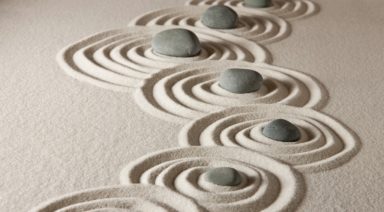3 Breathing Techniques To Unite Mind & Body

“The mind is the king of the senses, and the breath is the king of the mind.” -Hatha Yoga Pradipka
It was only until I discovered yoga years ago that I started to learn how to breathe properly. First off, I noticed how much I took my breath for granted. It was years of breathing in second-hand smoke as a child and suffering from depression and weight gain, etc. before I realized there was more to my breath than struggle and strife.
There are so many powerful breathing techniques (Pranayama in Sanskrit) that can treat myriad maladies, from depression to mental clarity, energy levels, and weight loss; the list goes on and on.
3 Pranayama that will help unite you in mind and body:
4-Point Yogic Breath
This breathing technique helps open the channel of the energy of the entire spine (Shushumna) and helps to clear blockages, energy spots along the spine (chakras) and the abdominal region, as well as increasing lung capacity. This technique also aids in weight loss, as you focus on bringing energy into the stomach and lungs.
- Sit up straight in a comfortable seated position
- Place your left hand on your belly and right hand on your chest. Breathe in through the nose, filling the belly first then expanding into the chest second.
- Exhale, starting with the chest and then stomach, creating a rippling wave through the hands as they rise and fall with your breath. The whole torso is breathing belly-chest, chest-belly, creating a 4-pointed yogic breath.
Alternate Nostril Breathing (Nadi Shodhana)
These breathing techniques calm the mind, bringing you sensations of happiness and peace. A few minutes of pranayama per day is best to destress the mind, releasing tension and fatigue. It’s named Nadi Shodhana Pranayama (NAH-dee sho-DAH-nah prah-nah-YAH-mah), as it helps clear out blocked energy channels in the body, which in turn calms the mind (nadi = subtle energy channel, shodhana = purifications, pranayama = breathing technique).
Sit comfortably with your spine erect and shoulders relaxed. Keep a gentle smile on your face and close your eyes.
- Place your left hand on the left knee, palms open to the sky or in Chin Mudra (thumb and index finger gently touching at the tips).
- Place the tip of the index finger and middle finger of your right hand in between the eyebrows, the ring finger and little finger on the left nostril, and the thumb on the right nostril. We will use the ring finger and little finger to open or close the left nostril and thumb for the right nostril.
- Press your thumb down on the right nostril and breathe out gently through the left nostril.
- Now breathe in from the left nostril and then press the left nostril gently with the ring finger and little finger. Removing the right thumb from the right nostril, breathe out from the right. Start 5 to 5 count inhales to exhales and work towards doubling exhale out.
- Breathe in from the right nostril and exhale from the left. You have now completed one round. Continue inhaling and exhaling from alternate nostrils.
- Complete nine rounds by alternately breathing through both the nostrils. After every exhalation, remember to breathe in from the same nostril from which you exhaled. Keep your eyes closed throughout and continue taking long, deep, smooth breaths without any force or effort.
Skull-shining Breath (Kapalabhati)
Kapalabhati Pranayama (kah-pah-luh-BAH-tee prah-nah-YAH-mah) is an intermediate-to-advanced technique that consists of short, powerful exhales and passive inhales. This exercise is a traditional internal purification practice, or kriya, that tones and cleanses the respiratory system by encouraging the release of toxins and waste matter (Kapala = skull, Bhati = light). It helps to cleanse the lungs, sinuses and respiratory system, which can help to prevent illness and allergies. Regular practice strengthens the diaphragm and abdominal muscles.
To begin, sit in a comfortable position where your spine is straight and your abdomen is not compressed. Some options include sitting upright in easy pose, on your heels in hero’s pose, or seated in a chair with your feet flat on the floor.
- Rest your hands on your knees, palms facing down.
- Bring your awareness to your lower belly. To heighten your awareness, you can place your hands, one on top of the other, on your lower belly rather than on your knees.
- Inhale through both nostrils deeply.
- Contract your low belly or use your hands to gently press on this area, forcing out the breath in a short burst.
- As you quickly release the contraction, your inhalation should be automatic and passive — your focus should be on exhaling.
- Begin slowly, aiming for 65-70 contractions per minute. Gradually quicken the pace, aiming for 95-105 exhalation/inhalation cycles per minute. Always go at your own pace and stop if you feel faint or dizzy.
- After one minute of the exercise, inhale deeply through the nostrils, and then exhale slowly through your mouth. Depending on your experience level, you may repeat the exercise.
Soham: Wisdom You Can Access

I first learned to meditate over 40 years ago. Friends of mine learned Transcendental Meditation in high school, but I couldn’t afford the fee. I had friends in college who also learned the TM method, but again, I was unable to pay and no one was parting with any information about the process. Stubbornly, I took it upon myself to research meditation techniques in the library and learned as much as I could. This was my introduction to mantras. I chose a mantra and one beautiful day, sitting under a tree, I gave it a whirl. It changed my life.
Your first mediation is never forgotten.
Eventually, I learned the TM method from a certified teacher. Although the basic idea was the same, I was given my mantra and in my first experience, felt a great opening of consciousness that I hadn’t experienced before. It was different. With this in mind, I began experimenting with mantras. One day, I meditated with the Soham mantra, not knowing what to expect. I found it to be peaceful, relaxing and connective in a way that’s hard to explain.
One With the Universe
Soham is Sanskrit and essentially means, “He whom I am.” It could be translated as, “I am He,” implying, “I am one with everything,” The “He” in this case is the Universe and the singularity of the divine. Soham is an ancient mantra and one that has been used in different ways, by numerous groups and societies. Some believe that it can connect us to what are known as, “The Ascended Masters.”
A Human Tendency to Expand and Interpret
The term “Ascended Masters” was coined in the 1930s and used to define spiritual adepts whom, after their time on Earth, ascend to a place where they help guide humanity and commune, or merge, with those who seek their wisdom. This movement gained great popularity and had a vast following, one that still exists today. This wasn’t the first time such an idea had been put forth. Theosophy, through Madame Blavatsky, had “The Great White Brotherhood.”
Many have accused Blavatsky’s work as being discriminatory, or outright racist. Some have pointed to her writings as being instrumental in helping to design theories for the Nazi party. It’s hard to know the actual truth behind all of this, but I genuinely don’t believe that Blavatsky had any such thoughts about singling out one race, or type of people, as being “less” than others. I’m certainly not an expert on Theosophical philosophy, but I’ve read some of her works and can see both sides of the argument. The complexity of her writing style is open to a myriad of different interpretations, as is often the case with any spiritually based text.
This brings me to a point. One of the things that human beings tend to do, is take a basic thought and then expand upon it, often to fulfill our own philosophical ideals and agendas. A quick look at history should convince us of the power of this process.
Through rhetoric and dogma, it’s often possible to reinterpret the underlying purpose of a text, in order to rationalize our unique point of view.
This has been done again and again in religion and is also a powerful tool in politics, where interpretations of founding documents are hotly contested and reviewed. Perhaps this is one of the dangers of proclaiming a text to be sacred. They may, in fact, be sacred, but the interpretation of these texts and ideas are usually man-made. Some seek to overcome this ambiguity through an individual, a human channeling a specific source, one pure and spiritually unquestionable. Enter the Ascended Masters, or so say those who believe in the doctrine.
I’m wary of most spiritual systems. It’s not my desire to demean, nor cast doubt upon, any religion or philosophy. I’m a metaphysician and have been a seeker for most of my life, so I’m used to being left out, considered odd, deemed ignorant, thought simpleminded, or daft. I’ve experienced way too much not to believe, but I’ve also seen enough to realize that there has to be a standard of feasibility that allows us not to be deluded, or worse.
This amorphous, subjective realm exists somewhere between hard fact and faith.
It’s for this reason that I’ll discuss the Ascended Master concept a bit differently than some might. I’ve known individuals who consulted with an Ascended Master, through a channel, and received advice, only to have another channel of the exact same Master contradict the advice earlier given. It always amazes me that the seeker is able to rationalize the discrepancy, through some excuse or the other. It speaks to the unreliability of the process at the very least, and to much bigger problems, at worst.
Ascended Masters: A Conceptual Offering
I believe that anything can be mined for its positive, beneficial value and doesn’t have to be presented in a specific form to be of use. This doesn’t imply that the Ascended Master belief isn’t valid, or is unworthy of study. I’ve known many who have been followers of its doctrine and received value in their lives, some through personal work and others through relying on a Master being channeled. It simply isn’t my way of doing things.
To be direct, it seems overly religious and even though the Masters are purported to be from various cultures and eras, it strikes me as being a form of Saint worship. As I said, there’s nothing wrong with that; it just isn’t my thing, but it still has value. With that in mind, let’s look at what it can offer you.
We Are Never Alone
A common thread throughout spiritual cultures is a belief in a place to where our consciousness can ascend to and there share information and commune with fellow members, past, present and future. These locations have different names, appearances and purposes, but they all share one goal, to help those in need, or who seek truth. By this doctrine, we are never alone.
I do believe that there is an intelligence that seeks to guide us, one that is powerful and ancient.
I consider this intelligence to be the accumulated knowledge and wisdom of all humanity, from the beginning to the present. I don’t see a need to identify specific members of our species in this, as that quickly turns into a form of worship and defeats the purpose. This could be considered a form of ancestral guidance, since it depends upon people who have passed, their only agenda to better their progeny, namely us. Incidentally, I consider our time on this planet to be just as important and to have the same goal.
If we’re not doing something to better the human experience, then we’re missing the point of being human.
How then can we find this place and connect? The ability to receive this information, this wealth of humanity, is not only possible, but within your grasp. It takes concentration, determination, sincerity and the ability to listen to truth without fear, or prejudice. I believe that this has been one of the motives behind much of the ritual that we have been obsessed with over the millennia. Luckily, connecting is much simpler than it sounds and one method of doing so is the use of mantras, one of them being Soham.
I mentioned earlier that I’ve used different mantras over the years and can attest to the fact that each mantra has a definitive and unique energy. Some of these mantras have had influences that I was able to discern, while others are still a mystery to me. Each sound in Sanskrit has a specific energy and combining different sounds can be like putting together commands on a computer, accessing more information than seems possible.
The Soham Mantra: The Oneness of All
The Soham mantra, by the very nature of its meaning, “I am He whom I am,” indicates an association with the divine monad, the oneness of all.
As one meditates upon this word, it becomes a personal appeal, from us to the Universe, to unite with everything. By extension, we are then connected to the wisdom of all and can gain an inner understanding of ourselves, perhaps otherwise inaccessible to the conscious mind. This is something that you can do and benefit from.
Practice: Soham Meditation
As with anything, there are different opinions as to how the Soham mantra should be used. I find it to be aligned with natural breathing. When I inhale, I think, “So.” When I exhale, I think, “Ham.” There are masters who contradict this, insisting that Ham is the inhale and So the exhale. There are just as many masters who disagree with them. Many practitioners vocalize their mantras aloud. I prefer silent mantra repetition and personally feel silence to be more powerful, but in truth, it’s completely up to you.
A simple way of using the Soham meditation is to sit in a relaxed way that connects you to your process. For me, it’s a comfortable chair; for others it may be a yoga position. Do what you feel connects you to your source. Close your eyes, or leave them open if you prefer, and begin reciting the mantra, either out loud or to yourself, and forget about a goal. Breathe in, “So.” Breathe out, “Ham.” Let the words resonate in your mind, but don’t overthink it. Be in the moment and allow yourself to be devoid of motive or purpose of thought, other than to be.
Your mind will race, but never scold it. Instead, smile and return to the mantra.
I never ask for information or wisdom directly, but you may do so if you choose. I open my mind to whatever may come. Sometimes it takes a few minutes, other times information is there quickly. I have meditations where nothing comes through at all, except a deep and profound sense of calm and the conviction that something much more powerful than me is present. That’s good enough for me. Once again, determination, patience and sincerity will eventually deliver results, often spectacularly.
The information is out there and is designed to be accessed by every one of us, not just channels who speak for Ascended Masters. There is nothing supernatural about any of this. In fact, I believe that this is an important part of Humanity. It seeks to guide us in the way that will make us better than we are and can help to pave the way for the future. It reasserts our ethics and redefines our values in an ever-changing world.
I consider it to be a link in the chain of the spiritual evolution of our species and I pray that we will always listen. Tap into the source and listen to the voice. Everyone will benefit. Never forget, it begins with us.
I wish you all peace and love.
















